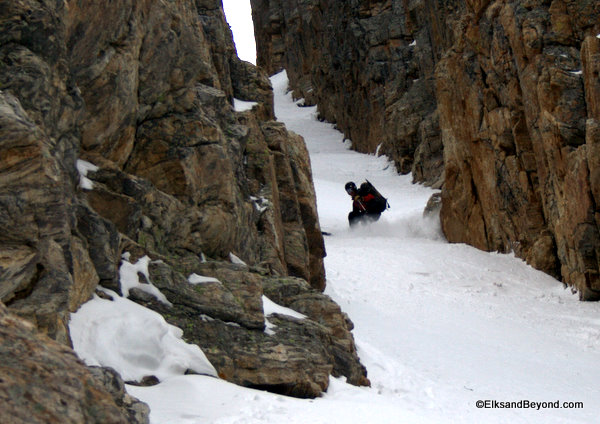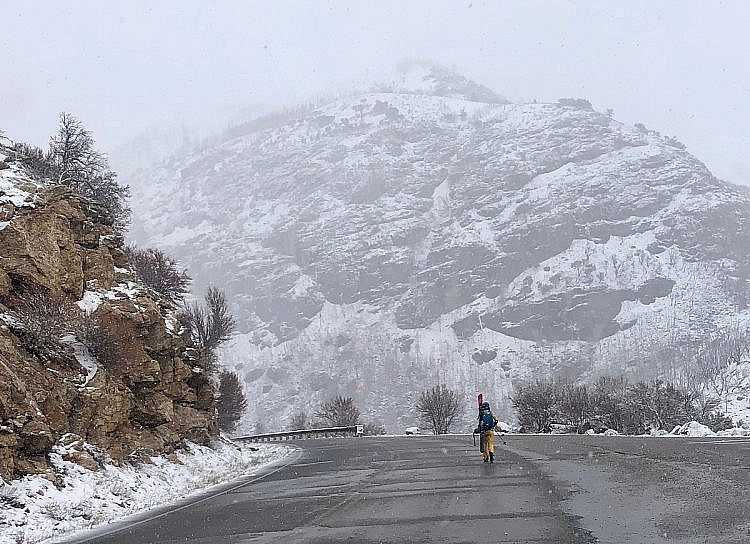So often in ski movies, magazines and blogs, over post-ski beers at the bar, we celebrate success: reaching the summit, dropping in to deep steep snow, spinning lofty turns that blow cold smoke in our faces. Most often, even turning around 100 feet from a summit, or surviving a descent riddled with breakable crust and windslab get the accolades of a good day out.
But some days, despite all the best intentions, any success of the skiing kind is as elusive as the vapor-shrouded line you’re looking to schuss. And some days, rather than skiing on the planks strapped to your backpack, you’re wearing them as you run down a road somewhere in Nevada, hoping you don’t end up in jail.
This was one of those days.
As Doug and I pulled into the entrance to Lamoille Canyon in the Ruby Mountains of Nevada in late May, we spotted the first (literal) bad sign in our plan to ski Terminal Cancer Couloir: concrete barriers with ROAD CLOSED pasted across them.
Maybe it’s a seasonal closure, we reasoned. The next bad sign appeared minutes later: late spring rain and soggy snow that smacked the van windshield as we parked near the barricade.
When the alarm rang at 5am the following morning, rain and soggy snow still smacked the windshield. We shrugged it off, shouldered packs with skis and boots attached and started walking up the wet barricaded road.
We passed clumps of heavy machinery lining the roadsides, taking note that the asphalt and surrounding hills were entirely, unmistakably free of snow minus what was falling from the sky. Was the closure in fact seasonal? Seemed suspect.
Low cloud vapor swallowed the textures of the surrounding canyon, obscuring any and all potential ski lines. Unbeknownst to us, when we first spotted Terminal Cancer Couloir, we walked right past it.
Terminal Cancer is a rare gem (pun intended) in Nevada’s Ruby Mountains. You didn’t know there was skiing in the Rubies? You’re not alone. This outpost mountain range is a mere 25 miles off I80 on the southeast flanks Elko. It’s host to a whole bunch of skiing, the likes of which we only caught the smallest glimpse of as the clouds cleared for a quick minute on the evening we rolled through town.
The most known line in the Rubies is Terminal Cancer Couloir, an 1800 foot splitter couloir that runs straight as a pencil from a pinched 14 feet wide at the top to 30 feet near the bottom until it fans out to the edge of Lamoille Creek. Distinguished by its novelty and reputed fun factor, it’s even featured in the venerable 50 Classic Ski Descents of North America. (Lou Dawson offered his own take on the naming of the couloir a few years back, which you can find here).

Praised for its beautiful, sustained 35-degree pitch sandwiched between dramatic rock walls, Terminal Cancer Couloir is a worthy rest stop for the skier passing through Nevada along I80. Pictured above: the fun, tight skiing we hoped to do, but didn’t. Photo: Anton Sponar
Trip reports we read as we crossed the border from Utah into Nevada called the line a “glorious descent,” and “more fun than the casinos you’ll find in Elko,” the overwhelming sentiment being that it’s worth the side trip if you’re in the area. En route to a ski trip around the Northwest, naturally, we couldn’t miss it.
But, skiing when traveling is different than skiing at home. When you stay close to your backyard, it’s easy to wake up in the morning and say ‘no’ or ‘go’ depending on weather and conditions. When you only have a day to reach an objective, though, you want to make it happen no matter what stands in the way.
Like a barricade, and a weather report forecasting 70% chance of precip, and fog so thick we couldn’t see 10 feet in front of us. After 3.3 miles (the distance from winter closure to couloir access we’d read about in trip reports) spent straining our eyeballs to try to see through the thick, soupy mist, we hadn’t spotted any notable ski lines but we kept walking, determined to make the day worth it.
On the road void of cars, an eerie silence hovered in the canyon, broken only by occasional drips from branches to asphalt. The squish of our footsteps. Our voices muffled by the thick air as we offered hopeful observations.
It seemed almost too quiet, like maybe we shouldn’t actually be there.
The low rumble of a diesel engine broke the stillness as a large white truck with a US Forest Service decal rolled to a stop beside us.
“How’d you get back here?” demanded a gruff voice from the truck cab.
Doug looked left and right at the sheer canyon walls, “We walked,” he responded curtly. Sopping wet from head to sneakers, it seemed pretty obvious to us.
“Walkin’ on this road is a federal offense,” the man said roughly. “This road is closed for construction. There was a public notice.”
“Sorry, we don’t live around here.” I replied, confused. Public notice? Where?
“I’m sorry,” Doug said quickly. “We were just trying to ski. Didn’t realize that closed meant closed to foot traffic.”
The man eyed us wearily and dismissed our apologies. “There’s gonna be a ticket waiting for you at the bottom. There’s dangerous machinery out here. We might even have to pack you out.”
He paused. “You keep walking. You see a construction crew, get 30 feet off the road. I gotta call this in.” And, slow as he came, he rolled away.
A federal offense? For walking on a closed road? Shoot. We started running.
Skis and boots bounced on packs and sneakers squished underfoot. Our five long miles felt like 20. Suddenly nothing sounded better than hitching a ride with the feds.
The truck rolled up beside us again. “Alright,” the man said, seeming to have softened some. “You feel ok getting out of here?”
We nodded.
“We’re not going to pack you out.” Damn.
“There’s a crew up ahead moving a guardrail. You get close to them, make sure they see you real good,” he paused again. “Just be careful.”
Skis and boots continued bouncing. When we spotted the crew, we gave wide berth as best we could given that the road was pinched between a cliff wall and steep drop to the valley floor.
Finally, we spotted our van in the distance, but before it, an idling USFS Law Enforcement Vehicle.
In the end, we got off with a warning.
“How were we supposed to know it was closed to foot traffic?” I asked.
“It’s the public’s responsibility to check notices,” the Law Enforcement Officer told us sternly after he’d recorded our information. “We can’t be putting signs for everything. There’d be signs all over the place.”
Got it.
Finally at the van, we dropped our piles of wet gear. I wrung my leather gloves out on the asphalt and pulled the liners out of the boots I never put on. We’d walked 11 road miles in the rain and snow, didn’t ski an inch and nearly got arrested.
And so, as we left Lamoille Canyon in the still pouring rain, we celebrated not a summit or even near summit, but instead the relief of dry clothes, records clear of felonies, and the knowledge we’d have another chance at ski success some other time, perhaps even, tomorrow.
Manasseh Franklin is a writer, editor and big fan of walking uphill. She has an MFA in creative nonfiction and environment and natural resources from the University of Wyoming and especially enjoys writing about glaciers. Find her other work in Alpinist, Adventure Journal, Rock and Ice, Aspen Sojourner, AFAR, Trail Runner and Western Confluence.

